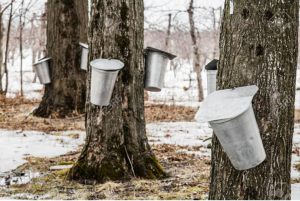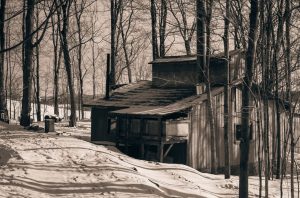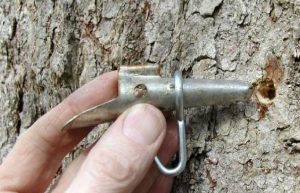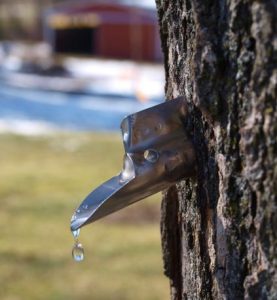Our Maple Syrup Camp
Although I was only 12 when our family last operated the Maple Syrup camp, it left a lasting impression. The camp was in the edge of the woods on my grandfather’s farm. The unpainted building or shed was about 16 x 28 feet with louvers along the roof to control draft and temperature inside the shed when the sap was being boiled to syrup. On one end, there was a round galvanized smoke stack about 20 feet high which provided draft for the wood burning evaporator.
An earthen ramp on the same end to accommodate the horse driven sled with a collection tank and one much small attached shed which protected a tank for sap waiting to be boiled. The opposite end had a door for bringing in the firewood.


An evaporator was located inside the shed, which was specifically designed for the processing maple syrup. At one end was the firebox, lined with brick, designed to accept 4-foot lengths of firewood. It tapered upward to direct heat against the bottom of the rear evaporator pans. Six flat pans, about 5 inches deep, 30 inches wide and 48 inches lined the top of the firebox.
A pipe from the sap holding tank ran through the near side of the evaporator pans. A simple valve arrangement, a rotating spout facilitated movement of sap from the holding tank to any pan, or movement between the pans. The evaporator pans made use of the pipe as a hinge, so the pans could be raised or lowered using a rope attached to the opposite side.
The process of making syrup was very simple. Sap was taken from the trees and was simply boiled until it was reduced to syrup. It requires about 40 gallons of sap to make one gallon of syrup, so a lot of firewood and patience are required.
Sap flows in early February into March. A good year provides about 6 weeks when maple trees produce quality sap that can be used. If it is too cold, the sap stops running and if it gets too warm, the buds begin to form and the season is over. In the 1930’s my father tapped up to 1000 trees. Larger trees could be tapped 2 or 3 times without excessive damage. Trees that are tapped become streaked with a dark streak, so they will never be sold as premium lumber.


The first activity after gathering an enormous amount of firewood was to wash over 1000 2 ½ gallon buckets. Then trees were tapped by drilling 3/8 inch holes into their trunks, about 2 inches deep and about 3 feet off the ground. Spiles, special tapered metal tubes with a lip on the end were tapped into the holes with a hammer and the buckets were hung on them. A lid covered the buckets to keep out rain water and other debris.
When the sap ran well, the buckets were emptied every other day into the collection tank hauled on a horse driven sled. The collection tank held about 100 gallons of sap. Sap runs best when the ground froze during the night but thawed during the day. It was normally a bit muddy in the woods and along the paths where the sled was drawn. At other times a couple of inches of snow would coat the woods.
When the collection tank was full, it was taken back to the camp and up the ramp at the end of the shed to be syphoned into the storage tank. The storage tank was in the small shed and was elevated sufficiently to gravity feed into the evaporator pans.
As a pre-teen, It was always fun to go through the woods and help empty the sap buckets.
Back in the camp, the pans were filled with sap and a hot fire was maintained in the firebox, sometimes on a 24/7 basis as long as those maple trees continued to produce quality sap. The first two pans were used to pre-heat the sap. The next two were used to reduce the sap to near syrup and the last 2 pans were used to finish. The boiling point increases at each stage and is quite high when it is nearly finished.
Pans are raised with the pulley arrangement to move the liquid from one pan to another. When one of the 2 rear pans finished, the sap from the front pans is transferred though the hollow hinge arrangement to the rear pans. Finishing was always done in the rear pans where the heat was more intense.
Precise density limits specified by federal standards dictate what can be sold as maple syrup. As a batch nears completion, the density and temperature is checked carefully and frequently. Precision is necessary as if batch is not reduced enough, the syrup will sour before it is used, and if it is overdone, it will crystalize into sugar. In either event, just reheating it will make it like new, but everyone does not know that. When a batch in one of the rear pans is boiled to the proper density, it is carefully transferred to a container where it cools. Handling this syrup is very dangerous, as it is extremely hot and it sticks to your skin. When cool, it was transferred into one gallon cans for sale.
First run syrup is premium syrup, as it is a very light amber color and has a subtle mild flavor. Later runs are darker and have a more distinct taste. Late runs are quite dark and begin to exhibit a little bitterness. The late runs still make very good candy and maple sugar, although we did not make any sugar.
Breaking the camp at the end of the season was less fun. All the buckets and spiles were collected, washed and stored for the following year.
Marketing the syrup was another issue. Standing orders accounted for many of the sales. The gallon cans were boxed and shipped to the Chicago (Hecklers), Iowa (Grahams), Kochs and others, mostly my great aunts and uncles. Dad delivered some to standing customers in the area and even did some door to door selling in Youngstown and Alliance. As I recall, the price was about one dollar per gallon for the better runs.
Maple Creams
Mother was an expert in making maple creams. The process is simple. Syrup is boiled to reduce it further. When a sample forms a string of taffy when dropped into cold water it is done. The hot syrup is gently poured into sauce dishes and allowed to cool to just the right temperature. If done properly, it remains clear amber in color. At just the right temperature, whip it rapidly with teaspoon and it will crystalize into a creamy state which can then be dropped into little round puddles with a curly top. The candy melts in your mouth, is very sweet and has a great maple taste. If it is boiled a little longer, it is more granular and is sold as maple sugar.